"I Found I Could Defeat Sciatica:" Norm's Story
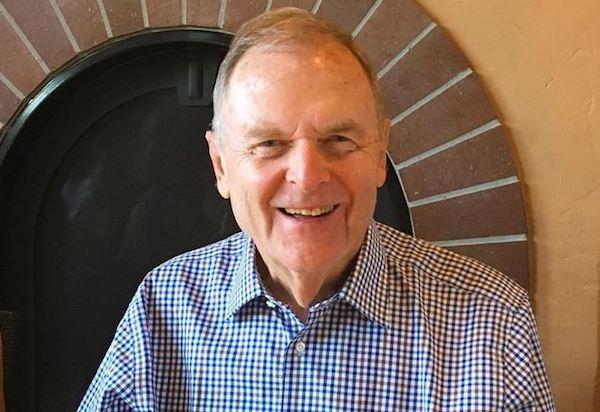
Photo courtesy Norman Crawford.
Norm, a hydrologic analyst and author now 82 years of age, originally hails from Alberta, Canada. When Norm was 16 years old, he accepted a summer job in Lake Louise (also known as Lake of the Little Fishes by the local Stoney Nakoda people), a location in the Canadian Rockies so known for its rugged beauty that it is frequently included on lists of “Wonders of the World.” This breathtaking landscape formed the backdrop for Norm’s lifelong love affair with the outdoors. Decades later, Norm still speaks of Lake Louise with understated reverence.

Lake Louise, Alberta, Canada, where Norm first fell in love with hiking. Photo courtesy Kevin Noble on Unsplash.
These days, Norm still loves spending time being active outdoors. When he’s home and not working on flood research or his novel, a favorite activity of Norm’s is walking the Stanford hills and campus. His family also owns a small cabin in the mountains near a lake he enjoys circumambulating daily. Perhaps it was his early exposure to the wilderness of Lake Louise which planted the seed of his passion for outdoor activity, a healthy and restorative passion he continues to feed.
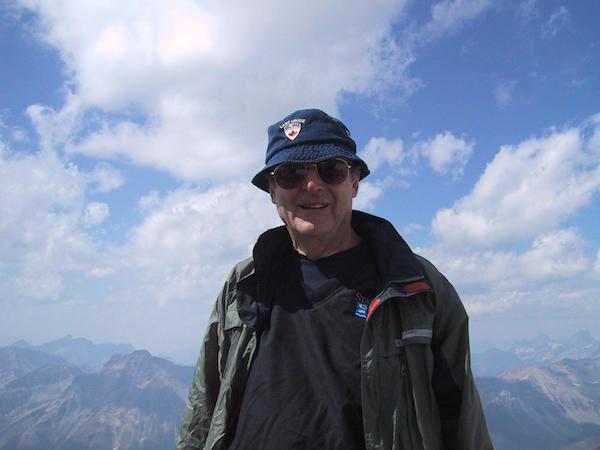
Norm has been fortunate to enjoy “quite a bit” of mountain hiking in his life: here he is summiting Mt. McArthur. Photo courtesy Norman Crawford.
Challenges to walking and hiking
Not long ago, however, Norm’s treasured outdoor activity began to be interrupted by lower back and leg pain. After only 30 minutes of walking, he would be in enough pain to have to stop and stretch out his legs. He’d then be able to continue for another 5-10 minutes before needing to stop again. The pain was significant enough that he was starting to avoid walking even his usual Stanford route. At the mountain cabin, he noticed himself avoiding the routine, 2-hour “rocky walk” around the lake, fearing pain. To be suddenly unable to take this routine walk was quite a disruption. Norm was afraid he’d have to give up the mountain hiking he’d enjoyed since his teenage years. More than that: he was also afraid of consigning himself to a shorter life of poorer quality. He’d seen similar effects firsthand after his father experienced a severe pole-vaulting leg fracture at age 45, and didn’t want that for himself. Norm decided to do something about his pain, rather than settle for a life like his father’s had become after his injury. He also wanted to strengthen his core, behind, and legs.
As Norm puts it, “it’s troubling to get old,” but he also sees aging, in part, as a state of mind. “It’s not true to say that I’m still 20,” he says by way of example, but “there’s a way to do things that you have not done before and to expand what you know.” Norm’s willingness “to try out other things” than what might be strictly familiar speaks to his adventurous approach to life and clearly benefits his mindset. As a hydrologic researcher, he’s enjoyed visiting countries where he couldn’t even begin to read the language, let alone speak it. More recently, since he’s begun Gokhale Method lessons and Continuing Education, Norm’s interest in retooling habitual behavior has benefitted not only his posture, but his enjoyment of life.

One of the important lessons Norm learned was the sequence of muscular contractions and relaxations that constitute walking. The Orissan man above shows the beginning of the relaxation phase of a stride — his left posterior chain muscles relax as his right leg takes on a more active role. His left foot’s shape continues to hold its own at this instant.
The Gokhale Method supplies Norm with very specific ways to strengthen his back and other muscles, as well as new ways of moving and walking. These techniques are drawn from nonindustrialized, indigenous cultures — cultures which Norm considers “less stressed” than ours. The specificity of the Gokhale Method techniques contrast with Norm’s earlier experience with the Alexander Technique, which he does not recall being as methodical and technique-oriented.
Our founder Esther Gokhale lives and teaches close to Norm, so he’s been “fortunate enough to take classes with the source,” and Norm holds her teaching expertise in high regard. Norm considers the lessons reasonably priced, particularly compared to the costs of MRIs and conventional medicine. He began lessons with Esther nearly a year and a half ago. Initially, Norm attended the lessons, listened to the instruction, and started working on the techniques, but admits he “didn’t really do things daily.” Eventually, he heard Esther say that if he wanted to gain more robust benefits, he’d have to perform the techniques daily. That shift from occasional to daily practice was when he began to see “major results.”
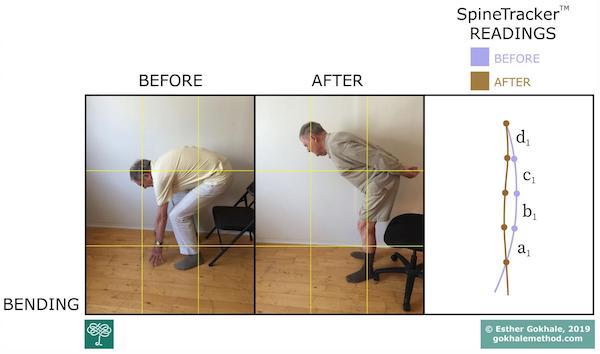
These before-and-after images and SpineTracker™ readings of Norm's hip-hinging indicate one way he has learned to protect his posture.
The benefits of adaptability
Since taking a Gokhale Method Foundations Course and Continuing Education, “what used to happen” to Norm in terms of pain “just doesn’t happen” anymore. That treasured 2-hour walk around the lake at the mountain cabin is something he wouldn’t hesitate to do now. Closer to home, he walks the same hour-plus Stanford routes he used to walk and doesn’t need to stop and doesn’t even feel uncomfortable. With a grin, Norm jokes that the results of treating his pain through posture seem to him like “black magic!”
Norm is living proof that, at any age, humans can learn and adapt to new situations, and can do things we’ve never done before. Rather than allowing himself to become “self-contained and narrow” in the way he does things as he ages, Norm prefers to change course and branch out, much like water does as it flows tirelessly around obstacles.

Like the water he’s researched for decades, Norm has found ways to respond and adapt to changing circumstances. Photo courtesy Ezra Comeau-Jeffrey on Unsplash.
In Norm’s own words:
When asked to say something about myself, my first impulse is self-aggrandizement, e.g. claiming I was born in a cabin I built myself. This impulse can’t survive the light of day, but if this text decamps and merges with late night camp-fire talk, beware. My work is hydrologic analysis and I have been fortunate to travel and work in many places in the world, including villages in the Amazon that have limited contact with the outside world.
I want to talk about teachers, and what we learn and don’t learn, and whether or not this changes with age. We do learn at an extraordinary rate between birth and age four; if you see a newborn and a four-year-old together, how could that transformation happen? College freshmen and graduates are different, but not that different. If you do reach seventy, or eighty, what then? Have you learned all that there is to learn?
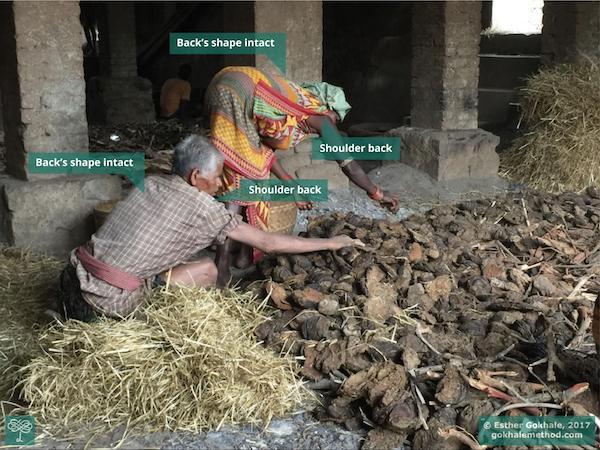
People like these Orissan potters were the models for Norm’s posture transformation.
Specifics, my inner editor demands. OK. I’ve had the good fortune to meet teachers over my eighty-plus years and retain some of what they had to say; in high-school an English and a physics teacher. In college, still more – a mathematics professor (whose name I don’t remember) who said the increase in computational speed (then about five orders of magnitude) would change human life. The teachers I remember had discovered or realized truths and wanted to make these truths known.
So, what happens with age? Things I could do at sixty-five, eighteen-hour mountain climbs, become problematic. I would love to do those climbs but my body says, “You can’t be serious.” I have to deal with loss. My mother-in-law, who lived to 102, said, “Old age is not for wimps.”
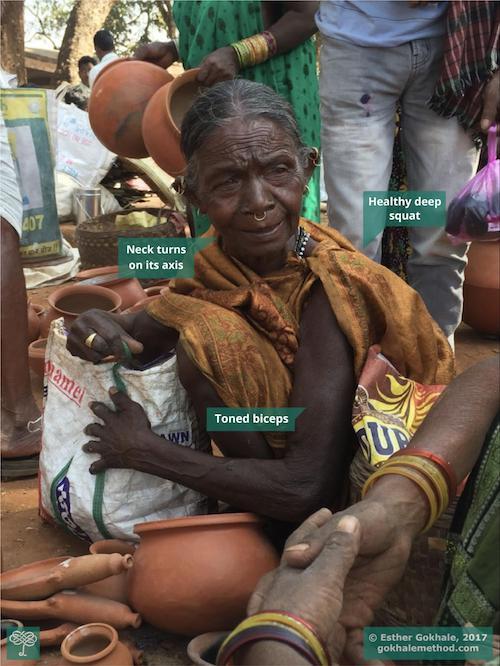
This elderly Orissan woman’s presence in the marketplace communicates a peaceful approach to aging. She actively participates in everyday life — her biceps tone tells that story — even as she sits out the most arduous tasks.
Dylan Thomas wrote, “Do not go gentle into that good night-” How can that be done? Esther Gokhale is a teacher. Listening to Esther, and learning finally that I had to work at the Gokhale Method, I found I could defeat sciatica. My expectation that ‘things get worse with age’ proved false.
Eighteen-hour mountain climbs? Not yet. Maybe next year.

Comments
Louis, I hear and respect
Louis, I hear and respect your thoughts. I would like to add, though, that my experience and research have netted the opposite understanding to yours. My experience is that changes in the way we stand, sit, walk, and move can indeed have profound and lasting benefits for pain relief.
I have found this to be true for me personally and for others I have known. My own issues developed from a bicycle crash at 20, following which I suffered back pain for years, sometimes quite severe. I worked with posture and body use through Tai Chi, Alexander Technique, Feldenkrais, meditation, inversion tables, Skinner Releasing, yoga, body mechanics instruction while attending massage school, probably also other methods not coming to mind at the moment, and finally the Gokhale Method - THE BEST. Now in my 60s, I spend several hours daily doing desk work but am otherwise physically active -- hiking (up to 10 mi), running (up to 5k), biking and mountain biking (24 mi yesterday), backpacking (typically a week on the trail with a pack of 28 pounds), gardening (including trimming trees, digging holes, etc.).... and have not suffered back pain for years. (Thank you, Esther!)
It may not be true for everyone, but it is true for many of us: Body positioning and use are major determinants in whether we can live pain-free.
Everyone's experience is
Everyone's experience is different. In order to make more general statements, I believe it helps to have data. Check out the ratings on the crowdsourcing website healthoutcome.org for what large numbers of people say about the interventions they have tried. The website has gathered over 157,000 ratings on 45 interventions including John Sarno's, Gokhale Method, Postural Modifications in general and the more usual chiropractic, massage, cortison injections, srugery, etc etc. The Gokhale Method is the top-rated intervention with a 4.3 out of 5 rating based on a statistically significant number (over 80) of ratings - 282 ratings. Postural Modifications comes next with a rating of 3.1. Sarno has a high rating of 3.6 but not enough ratings to be statistically significant yet.
Stanford did a study on these findings and published a paper in Springer called "Is Crowdsroucing the New Face of Evidence Based Medicine?" Short answer was yes - similar results to Randomized Control Trial results and some new interventions (like posture!) that come to light as effective.
I have respect for Dr. Sarno's work and sometimes send students to his book when I feel there's a strong psychological component and an undue amount of fear of engaging in daily activities. What I don't think is valid is the dissing of every other intervention. I think there's a lot of talent and skill out there - and some missing pieces. We're trying to fill a big missing piece - I believe Sarno fills in another significant gap.
Louis, I don't think you
Louis, I don't think you mentioned whether you had taken the Gokhale Method Foundations course. I'd be curious to know if you have. Thanks. Lynn
At 72, I am finding my
At 72, I am finding my results parallel Norm’s in a number of ways. (Go, Norm!). Took the foundations course in February after many months of mostly lying in bed and am now walking 5 miles most days! One thing: he is right about having to stay on it! Slacking costs
This is so good to hear - we
This is so good to hear - we need our wise elders in good shape! One day we hope you'll be able to stay on it and slack off at the same time - that will take everyone around you "beaming" good posture to you. We're working on it!
Add New Comment
Login to add commment
Login